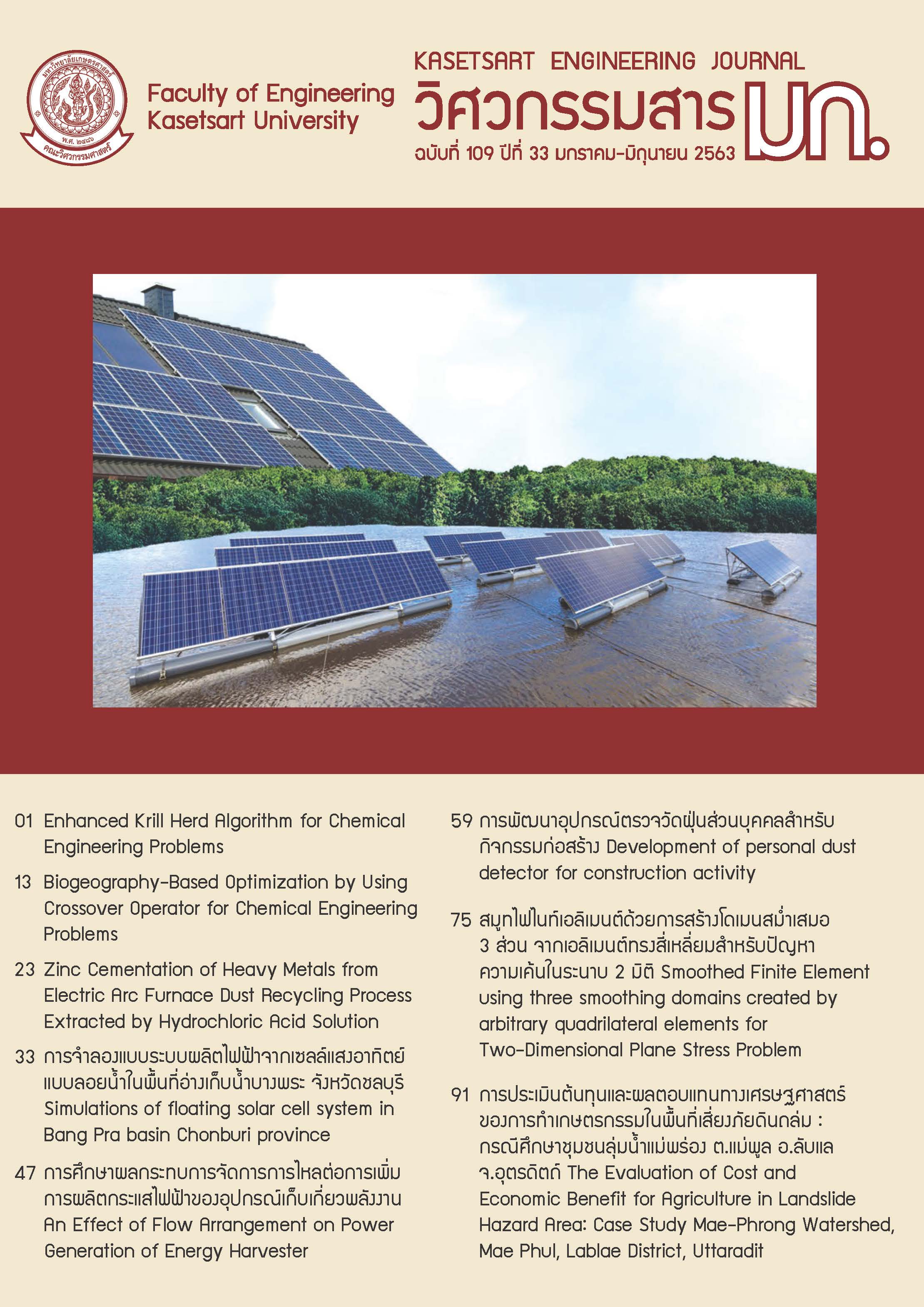สมูทไฟไนท์เอลิเมนต์ด้วยการสร้างโดเมนสม่ำเสมอ 3 ส่วน จากเอลิเมนต์ทรงเหลี่ยมสี่หน้าสำหรับปัญหาความเค้นในระนาบ 2 มิติ
คำสำคัญ:
สมูทไฟไนท์เอลิเมนต์, โดเมนสม่ำเสมอย่อย, การเปลี่ยนแปลงความชัน, ปัญหาความเค้นใน 2 มิติ, คานยื่นบทคัดย่อ
ทางเลือกของการสร้างโดเมนสม่ำเสมอย่อยภายในเอลิเมนต์สำหรับการวิเคราะห์สมูทไฟไนท์เอลิเมนต์ได้ถูกนำเสนอสำหรับงานวิจัยในครั้งนี้ โดเมนสม่ำเสมอย่อย 3 โดเมนถูกสร้างขึ้นมาด้วยการประยุกต์แนวคิดของความสมมาตรเพื่อให้เกิดการกระจายตัวของโดเมนย่อยดังกล่าวทั่วทั้งขอบเขตของปัญหา เทคนิคการเปลี่ยนแปลงความชันของความเครียดเป็นกุญแจสำคัญสำหรับการกระจายสนามความเครียดตลอดโดเมนสม่ำเสมอย่อย ปัญหาความเค้นในระนาบ 2 มิติซึ่งใช้สำหรับงานวิจัยคือคานยื่นปลายที่รับแรงเฉือนกระทำที่ปลายคานในรูปฟังก์ชันพาราโบล่าด้วยค่ามากสุดเท่ากับ 1,000 หน่วย พารามิเตอร์ควบคุมที่ใช้มี 2 แบบ อย่างแรกคือขนาดของโครงตาข่ายจากหยาบสุดซึ่งมีขนาด 16x4 ไปจนถึงขนาดละเอียด 48x12 ในอัตราส่วน 4:1 ซึ่งเป็นอัตราส่วนเดียวกันกับความยาวในแนวนอนต่อความลึกของคาน พารามิเตอร์ตัวที่สองคือ ซึ่งคิดเป็นเศษส่วนเทียบกับความยาวด้านของเอลิเมนต์โดยค่าที่ใช้คือ 0.2-0.3, 0.3-0.4 และ 0.4-0.5 ตามลำดับ ค่าความเค้นตั้งฉากและความเค้นเฉือน ณ หน้าตัดคานที่ระยะความยาวกึ่งกลางคานและค่าการเคลื่อนที่ของปลายคานซึ่งได้จากการวิเคราะห์เชิงตัวเลขถูกนำมาเปรียบเทียบกับค่าที่ได้จากทางทฤษฎีซึ่งคำนวณได้จากตำแหน่งเดียวกัน เห็นได้อย่างชัดเจนว่า ความแม่นยำของการเคลื่อนที่ปลายคานที่ได้ ขึ้นอยู่กับพารามิเตอร์ตัวที่สอง ความเค้นตั้งฉาก เมื่อ เท่ากับ 0.3-0.4 และ 0.4-0.5 นั้น พบว่ามีค่าใกล้เคียงกับค่าที่ได้ทางทฤษฎีและไม่แตกต่างกันกันอย่างมีนัยสำคัญ ในขณะที่ความถูกต้องของความเค้นเฉือน ที่คำนวณได้นั้น กลับพบว่าขึ้นอยู่กับจำนวนความละเอียดของโครงตาข่ายมากกว่าค่าของ
References
Lee NS and Bathe KJ (1993). Effects of element distortions on the performance of isoparametric elements. International Journal for numerical Methods in engineering, 36(20): 3553-76.
Belytschko T, Lu YY and Gu L (1994). Element‐free Galerkin methods. International journal for numerical methods in engineering, 37(2): 229-56.
Babuška I, Banerjee U and Osborn JE (2004). Generalized finite element methods—main ideas, results and perspective. International Journal of Computational Methods, 1(01): 67-103.
Beirão da Veiga L, Brezzi F, Cangiani A, Manzini G, Marini LD and Russo A (2013). Basic principles of virtual element methods. Mathematical Models and Methods in Applied Sciences, 23(01): 199-214.
Francis A, Ortiz‐Bernardin A, Bordas SP and Natarajan S (2017). Linear smoothed polygonal and polyhedral finite elements. International Journal for Numerical Methods in Engineering, 109(9): 1263-88.
Sukumar N and Tabarraei A (2004). Conforming polygonal finite elements. International Journal for Numerical Methods in Engineering, 61(12): 2045-66.
Talischi C, Paulino GH, Pereira A and Menezes IF (2012). PolyMesher: a general-purpose mesh generator for polygonal elements written in Matlab. Structural and Multidisciplinary Optimization, 45(3): 309-28.
Liu G, Dai K and Nguyen TT (2007). A smoothed finite element method for mechanics problems. Computational Mechanics, 39(6): 859-77.
Liu G-R and Trung N (2016). Smoothed finite element methods. CRC press.
Liu G, Nguyen‐Xuan H and Nguyen‐Thoi T (2010). A theoretical study on the smoothed FEM (S‐FEM) models: Properties, accuracy and convergence rates. International Journal for Numerical Methods in Engineering, 84(10): 1222-56.
Lee C-K (2016). Gradient smoothing in finite elasticity: near-incompressibility. Cardiff University.
Dai K and Liu G (2007). Free and forced vibration analysis using the smoothed finite element method (SFEM). Journal of Sound and Vibration, 301(3-5): 803-20.
Nguyen‐Xuan H and Nguyen‐Thoi T (2009). A stabilized smoothed finite element method for free vibration analysis of Mindlin–Reissner plates. Communications in Numerical Methods in Engineering, 25(8): 882-906.
Bordas SP, Rabczuk T, Hung N-X, Nguyen VP, Natarajan S, Bog T et al. (2010). Strain smoothing in FEM and XFEM. Computers & structures, 88(23-24): 1419-43.
Dai K, Liu G and Nguyen T (2007). An n-sided polygonal smoothed finite element method (nSFEM) for solid mechanics. Finite elements in analysis and design, 43(11-12): 847-60.
MATLAB. 9.7.0.1190202 (R2019b). Natick, Massachusetts: The MathWorks Inc.; 2018.
Felippa CA (2004). Introduction to finite element methods. University of Colorado.
Hildebrand FB (2012). Methods of applied mathematics. New York: Dover Publications.
Liu G (2008). A generalized gradient smoothing technique and the smoothed bilinear form for Galerkin formulation of a wide class of computational methods. International Journal of Computational Methods, 5(02): 199-236.
Liu G-R (2009). Meshfree methods: moving beyond the finite element method. Taylor & Francis.
Timoshenko SP and Goodier JN (1970). Theory of Elasticity (3rd edition). New York: McGraw-Hill.

